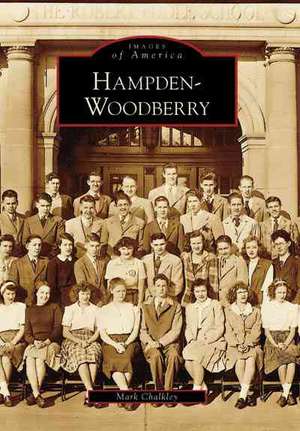Hampden-Woodberry: Images of America (Arcadia Publishing)
Autor Mark Chalkleyen Limba Engleză Paperback – 30 sep 2006
Din seria Images of America (Arcadia Publishing)
-
 Preț: 133.17 lei
Preț: 133.17 lei -
 Preț: 133.00 lei
Preț: 133.00 lei -
 Preț: 131.94 lei
Preț: 131.94 lei -
 Preț: 133.00 lei
Preț: 133.00 lei -
 Preț: 133.00 lei
Preț: 133.00 lei -
 Preț: 127.20 lei
Preț: 127.20 lei -
 Preț: 127.39 lei
Preț: 127.39 lei -
 Preț: 132.35 lei
Preț: 132.35 lei -
 Preț: 173.20 lei
Preț: 173.20 lei -
 Preț: 117.50 lei
Preț: 117.50 lei -
 Preț: 132.54 lei
Preț: 132.54 lei -
 Preț: 118.13 lei
Preț: 118.13 lei -
 Preț: 133.17 lei
Preț: 133.17 lei -
 Preț: 131.94 lei
Preț: 131.94 lei -
 Preț: 128.26 lei
Preț: 128.26 lei -
 Preț: 133.00 lei
Preț: 133.00 lei -
 Preț: 133.17 lei
Preț: 133.17 lei -
 Preț: 133.00 lei
Preț: 133.00 lei -
 Preț: 131.94 lei
Preț: 131.94 lei -
 Preț: 133.41 lei
Preț: 133.41 lei -
 Preț: 127.20 lei
Preț: 127.20 lei -
 Preț: 131.94 lei
Preț: 131.94 lei -
 Preț: 120.40 lei
Preț: 120.40 lei -
 Preț: 131.72 lei
Preț: 131.72 lei -
 Preț: 127.20 lei
Preț: 127.20 lei -
 Preț: 131.94 lei
Preț: 131.94 lei -
 Preț: 132.76 lei
Preț: 132.76 lei -
 Preț: 131.94 lei
Preț: 131.94 lei -
 Preț: 136.28 lei
Preț: 136.28 lei -
 Preț: 127.39 lei
Preț: 127.39 lei -
 Preț: 133.17 lei
Preț: 133.17 lei -
 Preț: 133.00 lei
Preț: 133.00 lei -
 Preț: 133.41 lei
Preț: 133.41 lei -
 Preț: 117.72 lei
Preț: 117.72 lei -
 Preț: 133.17 lei
Preț: 133.17 lei -
 Preț: 117.72 lei
Preț: 117.72 lei -
 Preț: 133.00 lei
Preț: 133.00 lei -
 Preț: 128.26 lei
Preț: 128.26 lei -
 Preț: 132.13 lei
Preț: 132.13 lei -
 Preț: 132.13 lei
Preț: 132.13 lei -
 Preț: 131.94 lei
Preț: 131.94 lei -
 Preț: 131.94 lei
Preț: 131.94 lei -
 Preț: 133.41 lei
Preț: 133.41 lei -
 Preț: 133.41 lei
Preț: 133.41 lei -
 Preț: 131.94 lei
Preț: 131.94 lei -
 Preț: 118.31 lei
Preț: 118.31 lei -
 Preț: 127.61 lei
Preț: 127.61 lei -
 Preț: 131.94 lei
Preț: 131.94 lei -
 Preț: 131.94 lei
Preț: 131.94 lei -
 Preț: 133.41 lei
Preț: 133.41 lei
Preț: 119.18 lei
Nou
Puncte Express: 179
Preț estimativ în valută:
22.81€ • 24.39$ • 19.01£
22.81€ • 24.39$ • 19.01£
Carte indisponibilă temporar
Doresc să fiu notificat când acest titlu va fi disponibil:
Se trimite...
Preluare comenzi: 021 569.72.76
Specificații
ISBN-13: 9780738543277
ISBN-10: 0738543276
Pagini: 128
Dimensiuni: 168 x 234 x 9 mm
Greutate: 0.33 kg
Editura: Arcadia Publishing (SC)
Seria Images of America (Arcadia Publishing)
ISBN-10: 0738543276
Pagini: 128
Dimensiuni: 168 x 234 x 9 mm
Greutate: 0.33 kg
Editura: Arcadia Publishing (SC)
Seria Images of America (Arcadia Publishing)
Descriere
The urban Baltimore neighborhood of Hampden-Woodberry began as a mill village in rural Baltimore County, where the swift-flowing waters of Jones Falls provided the power for early gristmills. As the nearby city grew into a major international port, the flour mills gave way to cloth mills that turned out cotton duck for sails. At their peak, the mills of Hampden-Woodberry turned out 80 percent of the world's cotton duck. Thousands of men, women, and children were employed in what was, in the late 19th century, the United States' largest concentration of factory labor. Fortunes were made by such men as Robert Poole and the Hooper, Carroll, and Gambrill families, who owned the mills. When it was annexed to Baltimore in 1888, Hampden-Woodberry was a thriving industrial community. The last of the mills closed in 1972, but many of these historic structures are now being reused for a variety of purposes. More importantly, Hampden-Woodberry still survives as a community with deep roots in America's industrial past.
Notă biografică
Mark Chalkley is a graduate of the University of Maryland and West Virginia University who taught for years at Baltimore City Community College. A Hampden resident, Chalkley worked with birthright Hampdenites to bring these images of the area's history to light and share them with a new generation.
